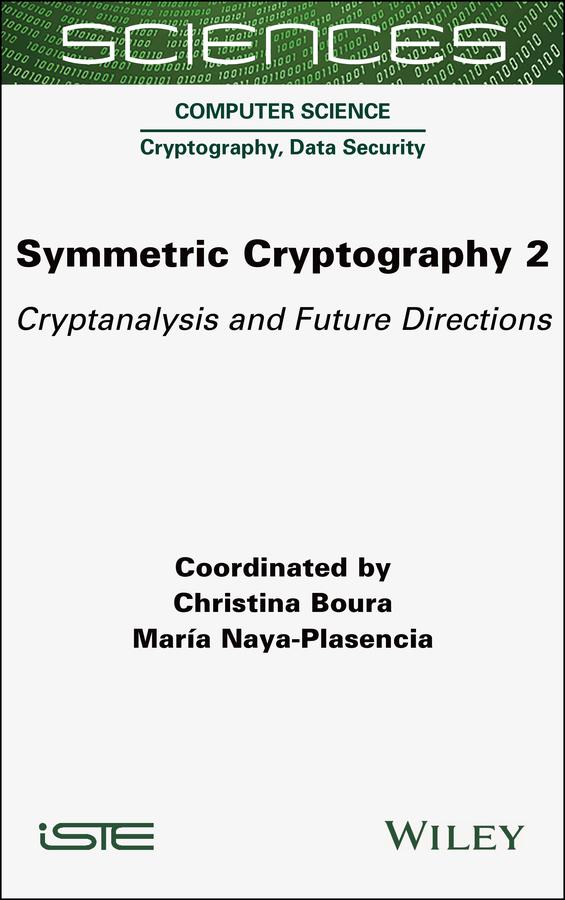Symmetric cryptology is one of the two main branches of cryptology. Its applications are essential and vital in the Information Age, due to the efficiency of its constructions.
The scope of this book in two volumes is two-fold. First, it presents the most important ideas that have been used in the design of symmetric primitives, their inner components and their most relevant constructions. Second, it describes and provides insights on the most popular cryptanalysis and proof techniques for analyzing the security of the above algorithms. A selected number of future directions, such as post-quantum security or design of ciphers for modern needs and particular applications, are also discussed.
We believe that the two volumes of this work will be of interest to researchers, to master's and PhD students studying or working in the field of cryptography, as well as to all professionals working in the field of cybersecurity.
Inhaltsverzeichnis
Preface xiii
Christina Boura and Marí a Naya-Plasencia
Part 1 Cryptanalysis of Symmetric-key Algorithms 1
Chapter 1 Differential Cryptanalysis 3
Henri Gilbert and Jé ré my Jean
1. 1. Statistical attacks on block ciphers: preliminaries 4
1. 2. Principle of differential cryptanalysis and application to DES 7
1. 2. 1. Differential transitions and differential characteristics 7
1. 2. 2. Derivation of non-trivial differential characteristics 10
1. 2. 3. Leveraging characteristics to mount a key-recovery attack 14
1. 3. Some refinements and generalizations 18
1. 3. 1. Differential effect 18
1. 3. 2. Truncated differentials 19
1. 4. Design strategies and evaluation 20
1. 4. 1 Case of the AES 21
1. 4. 2. Automated analysis 23
1. 5. Further notes and references 23
1. 6. References 26
Chapter 2 Linear Cryptanalysis 29
Kaisa Nyberg and Antonio Fló rez-Gutié rrez
2. 1. History 29
2. 2. Correlation and linear hull 30
2. 3. Multidimensional linear approximation 31
2. 4. Walsh-Hadamard transform 32
2. 5. Linear approximation of an iterative block cipher 32
2. 6. Matsui's Algorithm 1 type of key recovery 33
2. 7. Matsui's Algorithm 2 type of key recovery 34
2. 8. Searching for linear approximations and estimating correlations 35
2. 9. Speeding up key recovery 36
2. 10. Key-recovery distinguisher 38
2. 11. Classical model of Algorithm 2 39
2. 12. Algorithm 2 with distinct known plaintext and randomized key 40
2. 13. Multiple linear approximations 40
2. 14. Multidimensional linear cryptanalysis 42
2. 15. References 43
Chapter 3 Impossible Differential Cryptanalysis 47
Christina Boura and Marí a Naya-Plasencia
3. 1. Finding impossible differentials 48
3. 2. Key recovery 49
3. 2. 1. Data, time and memory complexities 50
3. 3. Some improvements 52
3. 3. 1. Early abort technique 52
3. 3. 2. Multiple impossible differentials or multiple extension paths 53
3. 4. Applications 54
3. 5. References 54
Chapter 4 Zero-Correlation Cryptanalysis 57
Vincent Rijmen
4. 1. Correlation and linear cryptanalysis 57
4. 1. 1. Correlation matrix 57
4. 1. 2. Linear trails and linear hulls 58
4. 1. 3. Approximations of linear functions 59
4. 1. 4. Computing the correlations over a permutation 60
4. 2. Attacks using a linear hull with correlation zero 60
4. 2. 1. Correlation zero in random permutations 61
4. 2. 2. Distinguisher 61
4. 2. 3. Reducing the data complexity 62
4. 3. Linear hulls with correlation zero 62
4. 3. 1. Feistel ciphers 63
4. 3. 2. AES 64
4. 3. 3 Extended result on AES 64
4. 4. References 64
Chapter 5 Differential-Linear Cryptanalysis 67
Yosuke Todo
5. 1. Brief introduction of differential-linear attacks 67
5. 2. How to estimate correlations of a differential-linear distinguisher 69
5. 3. On the key recovery 71
5. 4. State of the art for differential-linear attacks 72
5. 4. 1. Differential-linear connecting table 72
5. 4. 2. Three techniques to improve differential-linear attacks 73
5. 5. References 76
Chapter 6 Boomerang Cryptanalysis 77
Ling Song
6. 1. Basic boomerang attack 77
6. 2. Variants and refinements 79
6. 3. Tricks and failures 80
6. 4. Formalize the dependency 83
6. 5. References 86
Chapter 7 Meet-in-the-Middle Cryptanalysis 89
Brice Minaud
7. 1. Introduction 89
7. 2. Basic meet-in-the-middle framework 90
7. 2. 1. The 2DES attack 90
7. 2. 2. Algorithmic framework 91
7. 2. 3. Complexity analysis and memory usage 92
7. 3. Meet-in-the-middle techniques 94
7. 3. 1. Filtering 94
7. 3. 2. Splice-and-cut 96
7. 3. 3. Bicliques 97
7. 4. Automatic tools 98
7. 5. References 98
Chapter 8 Meet-in-the-Middle Demirci-Selç uk Cryptanalysis 101
Patrick Derbez
8. 1. Original Demirci-Selç uk attack 101
8. 2. Improvements 103
8. 2. 1. Data/time/memory trade-off 104
8. 2. 2. Difference instead of value 104
8. 2. 3. Multiset 105
8. 2. 4. Linear combinations 105
8. 2. 5. Differential enumeration technique 106
8. 3. Finding the best attacks 108
8. 3. 1. Tools 108
8. 3. 2. Results 109
8. 4. References 109
Chapter 9 Invariant Cryptanalysis 111
Christof Beierle
9. 1. Introduction 111
9. 2. Invariants for permutations and block ciphers 112
9. 2. 1. Invariant subspaces 113
9. 2. 2. Quadratic invariants 117
9. 3. On design criteria to prevent attacks based on invariants 117
9. 4. A link to linear approximations 119
9. 5. References 121
Chapter 10 Higher Order Differentials, Integral Attacks and Variants 123
Anne Canteaut
10. 1. Integrals and higher order derivatives 123
10. 2. Algebraic degree of an iterated function 126
10. 3. Division property 128
10. 4. Attacks based on integrals 130
10. 4. 1. Distinguishers 130
10. 4. 2. Attacks 130
10. 5. References 131
Chapter 11 Cube Attacks and Distinguishers 133
Itai Dinur
11. 1. Cube attacks and cube testers 133
11. 1. 1. Terminology 134
11. 1. 2. Main observation 135
11. 1. 3. The basic cube attack 136
11. 1. 4. The preprocessing phase on cube attacks 137
11. 1. 5. Cube testers 138
11. 1. 6. Applications 139
11. 2. Conditional differential attacks and dynamic cube attacks 140
11. 2. 1. Conditional differential attacks 140
11. 2. 2. Dynamic cube attacks 140
11. 2. 3. A toy example 140
11. 3. References 141
Chapter 12 Correlation Attacks on Stream Ciphers 143
Thomas Johansson
12. 1. Correlation attacks on the nonlinear combination generator 144
12. 2. Correlation attacks and decoding linear codes 145
12. 3. Fast correlation attacks 146
12. 3. 1. Fast correlation attacks and low weight feedback polynomials 147
12. 3. 2. Finding low weight multiples of the feedback polynomial 148
12. 3. 3. Fast correlation attacks by reducing the code dimension 150
12. 4. Generalizing fast correlation attacks 151
12. 4. 1. The E0 stream cipher 151
12. 4. 2. The A5/1 stream cipher 152
12. 5. References 153
Chapter 13 Addition, Rotation, XOR 155
Lé o Perrin
13. 1. What is ARX? 155
13. 1. 1. Structure of an ARX-based primitive 156
13. 1. 2. Development of ARX 156
13. 2. Understanding modular addition 157
13. 2. 1. Expressing modular addition in Fn2 158
13. 2. 2. Cryptographic properties of modular addition 158
13. 3. Analyzing ARX-based primitives 160
13. 3. 1. Searching for differential and linear trails 160
13. 3. 2. Proving security against differential and linear attacks 161
13. 3. 3. Other cryptanalysis techniques 162
13. 4. References 163
Chapter 14 SHA-3 Contest Related Cryptanalysis 167
Yu S Asaki
14. 1. Chapter overview 167
14. 2. Differences between attacks against keyed and keyless primitives 168
14. 3. Rebound attack 169
14. 3. 1. Basic strategy of the rebound attack 169
14. 3. 2. Rebound attack against AES-like structures 171
14. 4. Improving rebound attacks with Super-Sbox 173
14. 5. References for further reading about rebound attacks 175
14. 6. Brief introduction of other cryptanalysis 176
14. 6. 1. Internal differential cryptanalysis 176
14. 6. 2. Rotational cryptanalysis 177
14. 7. References 177
Chapter 15 Cryptanalysis of SHA-1 181
Marc Stevens
15. 1. Design of SHA-1 181
15. 2. SHA-1 compression function 182
15. 3. Differential analysis 184
15. 4. Near-collision attacks 184
15. 5. Near-collision search 185
15. 6. Message expansion differences 186
15. 7. Differential trail 187
15. 8. Local collisions 187
15. 9. Disturbance vector 188
15. 10. Disturbance vector selection 189
15. 11. Differential trail construction 190
15. 12. Message modification techniques 190
15. 13. Overview of published collision attacks 191
15. 14. References 192
Part 2 Future Directions 195
Chapter 16 Lightweight Cryptography 197
Meltem Sö nmez Turan
16. 1. Lightweight cryptography standardization efforts 197
16. 2. Desired features 198
16. 3. Design approaches in lightweight cryptography 200
16. 4. References 202
Chapter 17 Post-Quantum Symmetric Cryptography 203
Marí a Naya-Plasencia
17. 1. Different considered models 204
17. 1. 1. With respect to the queries 204
17. 1. 2. With respect to memory 205
17. 2. On Simon's and Q2 attacks 206
17. 2. 1. Off-line Simon's attack 207
17. 3. Quantizing classical attacks in Q 1 207
17. 3. 1. About collisions 207
17. 4. On the design of quantum-safe primitives 208
17. 5. Perspectives and conclusion 209
17. 5. 1. About losing the quantum and classical surname 209
17. 5. 2. No panic 209
17. 6. References 209
Chapter 18 New Fields in Symmetric Cryptography 215
Lé o Perrin
18. 1. Arithmetization-oriented symmetric primitives (ZK proof systems) 216
18. 1. 1. The current understanding of this new language 217
18. 1. 2. The first attempts 218
18. 1. 3. Cryptanalysis 219
18. 2. Symmetric ciphers for hybrid homomorphic encryption 220
18. 2. 1. The current understanding of this new language 221
18. 2. 2. First design strategies 221
18. 3. Parting thoughts 223
18. 4. References 223
Chapter 19 Deck-function-based Cryptography 227
Joan Daemen
19. 1. Block-cipher centric cryptography 227
19. 2. Permutation-based cryptography 227
19. 3. The problem of the random permutation security model 228
19. 4. Deck functions 228
19. 5. Modes of deck functions and instances 229
19. 6. References 230
List of Authors 231
Index 233
Summary of Volume 1 239













